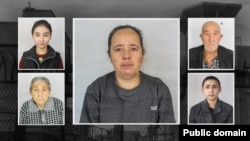On May 24, a new trove of documents and photographs came to light that further details alleged human rights abuses in China’s mass-detention program targeting ethnic Uyghurs in Xinjiang.
The cache of documents, dubbed the Xinjiang Police Files, were hacked from police computer servers in Xinjiang, where Beijing’s persecution of Uyghurs and other Muslim minority groups has been called a crime against humanity by international human rights organizations.
The hacked files, received by Xinjiang-focused researcher Adrian Zenz, include thousands of photographs of people incarcerated in internment camps, as well as classified government documents that include those describing a shoot-to-kill policy for detainees who try to escape.
In sum, the documents and photos, some of which show detainees bound during interrogation or guarded by figures in tactical gear, refute China’s claims that its detention centers are benign re-education facilities.
The leak coincided with this week’s visit to Xinjian by U.N. human rights chief Michelle Bachelet. At a press briefing, the Chinese Foreign Ministry spokesman was asked to confirm whether the files were “legitimate content from Chinese police servers.”
Instead, spokesman Wang Wenbin dismissed the leak as “the latest example of the anti-China forces’ smearing of Xinjiang.”
“The lies and rumors they spread cannot deceive the world,” he said.
That is misleading.
Publication of the Xinjiang Police Files came after a months-long effort to investigate and authenticate the leaked materials by a research team at the Washington-based Victims of Communism Memorial Foundation (VCMF), where Zenz is a senior fellow, and the media consortium.
According to Zenz, the files “were obtained by an individual who gained access to the internal police computer networks of two predominantly Uyghur and Kazakh counties in Xinjiang: Konasheher (Shufu) and Tekes (Tekesi).”
The leaker, who remained anonymous for security reasons, passed on the files to Zenz, who then shared them with the media consortium earlier this year.
The files, most dating to 2017-2018, reveal new information about the internment camps in Xinjiang, which Beijing calls “vocational skills education and training centers (VSETC).”
According to the VCMF, the files include:
- Mug shots of more than 2,800 detainees and images of police drills and police interrogation. The youngest detainee photographed was 14-year-old Rahile Omer.
- Confidential government documents, including police spreadsheets of detainees, lists of police staff and guards and security directives.
- Raw transcripts of internal speeches by senior Chinese Communist Party (CCP) officials, some of which serve as “evidence tying central government officials to the atrocity.”
Zenz analyzed and authenticated the files in a peer-reviewed academic paper published in the Journal of the European Association for Chinese Studies on May 24.
In the paper, he reviewed high-ranking CCP officials’ internal speeches and policy documents by comparing them to “previously-published internal state documents.” That is a reference to the Xinjiang Papers, a cache of Chinese government documents on Xinjiang leaked to The New York Times by a “member of the Chinese political establishment” and published in 2019.
Zenz examined the authenticity of photographs.
“Based on image-linked ID numbers, images were examined by age group, gender, and the location and sequence in which they were taken. The IDs were then compared to sets of other IDs contained in the files, as well as to external sources,” he explained in the paper.
“Where available, image metadata such as date and camera serial number were analyzed, permitting assessments of whether images were taken using identical or different cameras,” he added. “Internment facility locations were corroborated using satellite imagery, construction bids, and geolocation analysis that matched internal documents and images of facilities with corresponding satellite images.”
The 14 media outlets conducted their own independent work on the Xinjiang Police Files.
For example, the BBC said the images “can be verified by being shown to contain real people, identified as the missing relatives of a number of overseas Uyghurs approached by the BBC.”
The BBC was able to “verify the spreadsheets containing the photographs, ID numbers and cell phones for camp police officers.”
“[A]fter dialing the numbers listed for more than 150 police officers and government officials, several picked up and confirmed their names, roles and respective offices,” the BBC said.
USA Today said that while the consortium was “not able to independently verify the authenticity of all the data and photographs in the files,” the group “found evidence to support Zenz's conclusions.”
“Some photos include geolocation data that places them near the detention center Zenz identified. One of the party officials is known to have visited Xinjiang on the date cited in his speech. And coalition journalists interviewed Uyghurs, no longer living in China, who identified relatives who appear in the files,” the newspaper reported.
The documents add to body of leaked Chinese government documents, witness accounts and satellite imagery that have revealed mass detentions in both the VSETCs and formal prisons since 2017.
France’s Le Monde newspaper, which also reviewed the hacked files, wrote that they “tell the inside story of Beijing's security obsession with this Muslim minority and shed light on the repressive nature of the ‘re-education’ of Uyghurs in ‘vocational training centres.’”
The Chinese government has consistently dismissed accusations of human rights violations in Xinjiang as “lies and rumors” fabricated by “anti-China forces.”
The Chinese assert that the “re-education” camps are intended to improve the detainees’ vocational skills and alleviate poverty. Beijing also says that some of the security measures are part of a campaign to combat what it calls extremism and terrorism by Uyghur separatists.
“Xinjiang has taken a host of decisive, robust and effective deradicalization measures,” Liu Pengyu, a spokesperson with the Chinese Embassy in Washington, D.C., said in a statement responding to a list of questions about the files from the consortium of media outlets.
“The region now enjoys social stability and harmony, as well as economic development and prosperity. The local people are living a safe, happy and fulfilling life,” Liu said.
Liu did not address the reporters’ specific questions about the leaked files.





